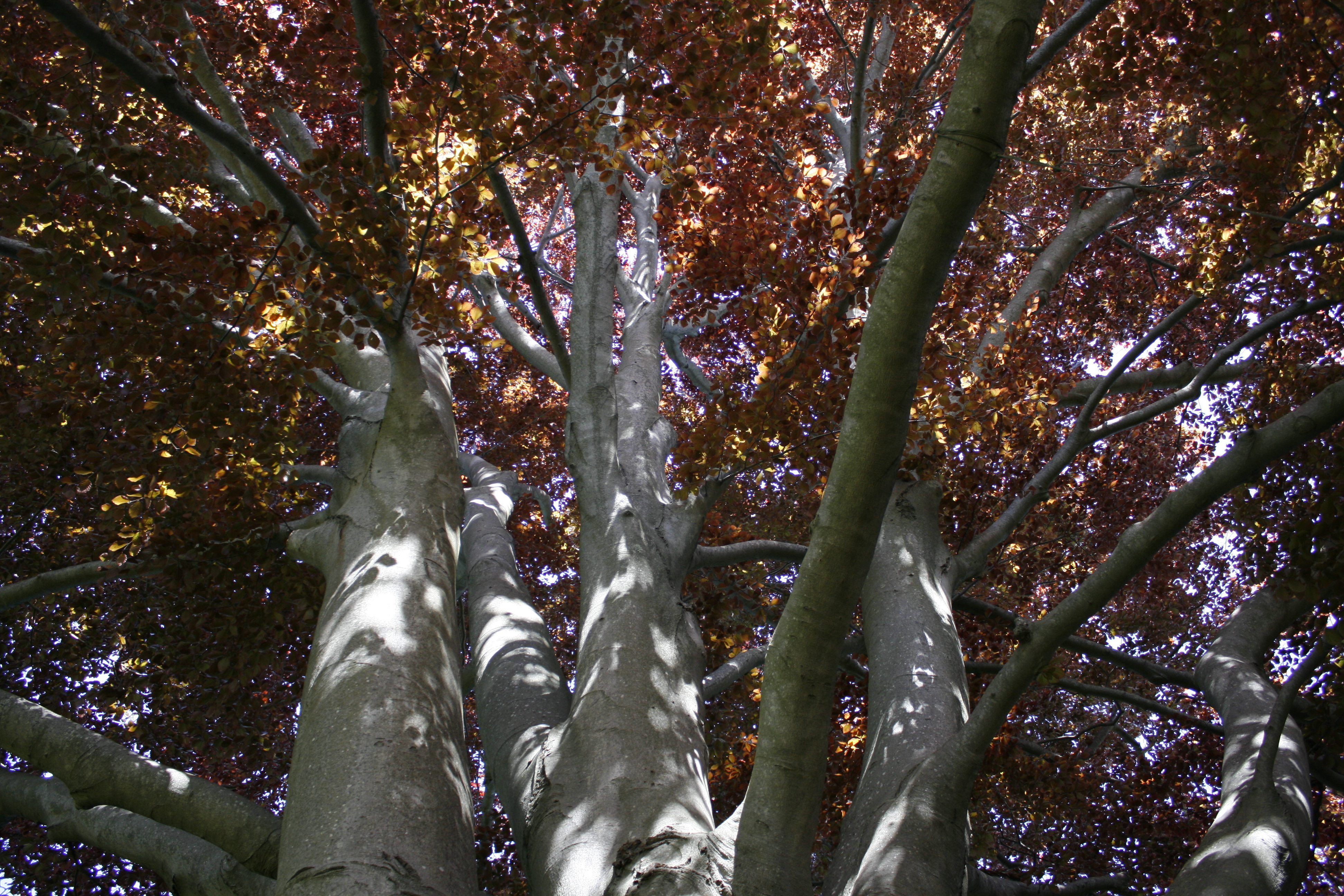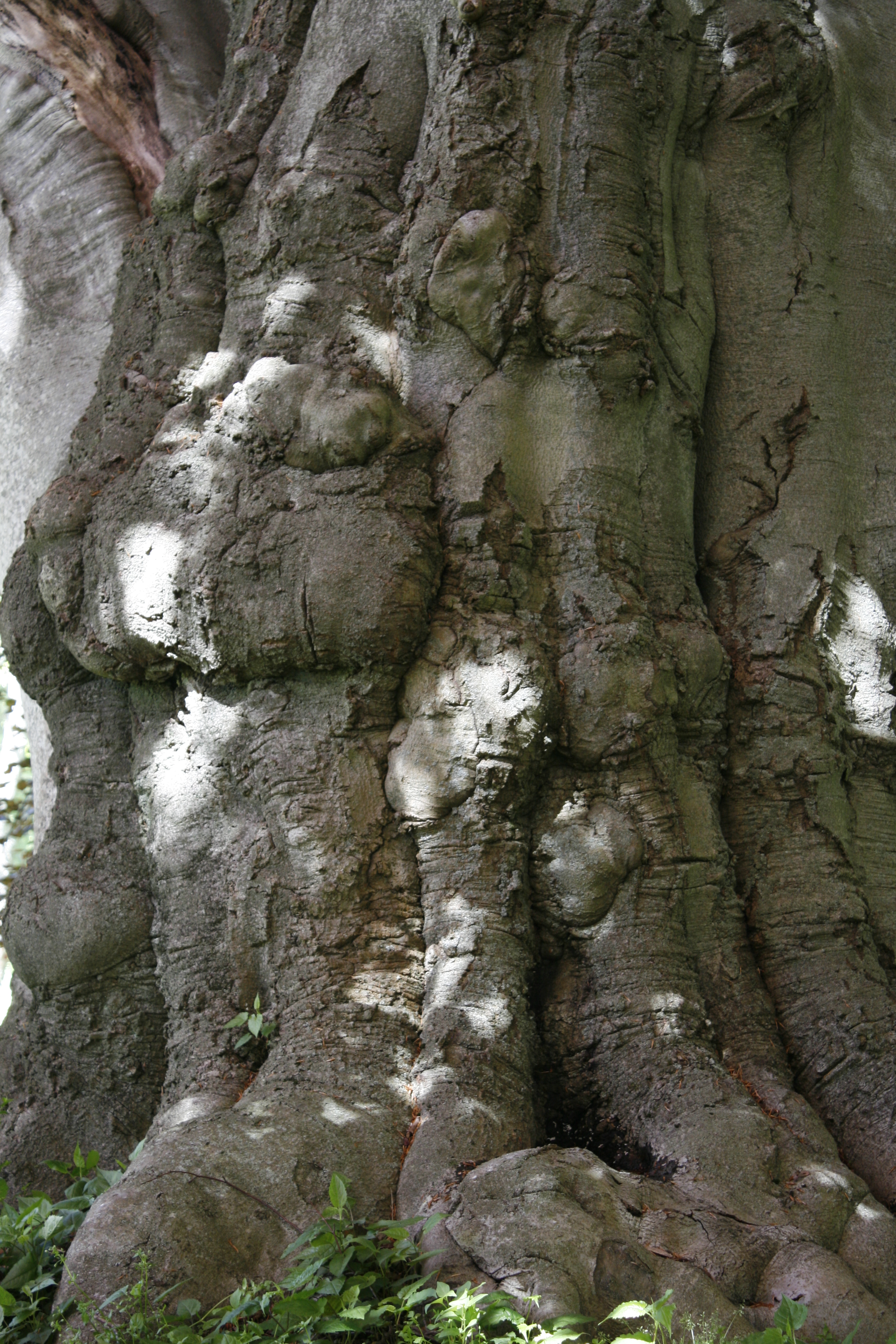Beech-Nut
Originally published in TCIA Magazine.
“Since youthful lovers in my shade
Their vows of truth and rapture made
And on my trunks surviving frame
Carved many a long forgotten name…”
From Thomas Campbell’s 1805 poem, “The Beech Tree’s Petition”
It was unlikely we would have much in common. The old-school, Yankee octogenarian and I were tooling around the property in his golf cart, a painful occurrence of gout limiting his mobility. Mr. V’s gruff manor was somewhat off-putting, but this was a beautiful estate, full of mature, specimen trees. It would be foolish to let the opportunity pass.
We stopped at numerous sites, assessing and discussing the various trees. As we cruised along, a fondness for some of his charges became more apparent, but never more so than when we rolled to a stop under a magnificent European Copper Beech. Ninety feet tall and about as wide, the specimen nicely complemented the stately residence. The deep maroon color stood out boldly in the landscape. Dappled layers of light shimmered off the silver bark. As we both sat in silent admiration, a connection was made. I went on to care for Mr. V’s trees until his death, and continue to do so for his family today.

I don’t know if there is a more inviting tree to climb. The low reaching scaffolds offering a stairway to heaven. No rough fissures, thorns or sap. The bark is smooth and cool to the touch. The limbs seem to be just the right distance apart and strong enough to let you ascend to the sky.
In Sweden, the word “bok” translates to both “beech tree” and “book”. Beech-wood writing tablets were used in early Germanic culture before paper. With the advent of writing, knowledge could now be recorded, stored, and passed on. Hence, the Druids linked Beech with the mystical powers embodied in written wisdom. There is, of course, the other mystical property as an ingredient in Budweiser (Beech-wood aged).
The European beech (Fagus sylvatica) is native to parts of Denmark, Norway and Sweden. Some research suggests its spread through continental Europe is linked to agricultural patterns. The purple variety was found growing naturally in three or four places in central Europe, the first written accounts appearing around 1680. While there is no record of the date of introduction to the U.S., it was noted in both George Washington and Thomas Jefferson’s plant lists.
Early Americans were far more dependent on plants for food than ornamental properties. Nursery catalogues once consisted primarily of fruit producing woody plants and herbaceous materials. It wasn’t until the early 1800’s with the development of real estate and a new focus on picturesque landscapes that Beech trees began to appear in nurseries.
Characteristics of the Beech tree seemed to embody nature as an art form, in line with the English landscapes that employed the use of large distinctive shade trees as an architectural anchor. Noted horticulturists like Fredrick Law Olmsted and A.J. Downing were on the forefront of bringing the English landscape into the suburbs, cemeteries, and urban parks of a flourishing American populace.

The industrial revolution and subsequent wealth resulted in the building of large palatial estates in areas like Newport R.I. and Long Island, N.Y. Large, distinctive trees were highly sought after to complement the scale of the architecture, and large transplants were not uncommon. Labor was cheap at the time, and trees with root balls as large as 30’ were moved by barge and truck to their new homes.
A vast variety of Fagus sylvatica cultivars have been introduced over the years. The “Atropurpurea” group and “Riversii” varieties feature deep purple leaves. Fastigate varieties such as “Dawyck” offer an option for tight spaces. And who could not be enthralled by the charms of “Pendula”, the gracious Weeping beech?
In its’ native range, the European beech grows in pure stands, suppressing any understory with dense shade and a shallow root system. A wide crown with a low branching pattern will develop in the open landscape, requiring lots of room to grow. It is intolerant of competition for root space with other plants. They will grow in a wide range of soil conditions, though a moist, well-drained soil with a ph of 5.0 – 6.5 is ideal. Wet or compacted soils with less than 10-15% oxygen levels are not suitable.
Beech does best in full sun, but will tolerate some shade. The bark is rather thin skinned and easily damaged, especially when breaking dormancy. These and other factors call for special considerations when caring for beech trees.
Planting – You will need lots of room, and a willingness to dedicate the root zone to the tree. Expand a mulched zone as the tree grows and refrain from planting anything else. Try to find a site with good soil, exhibiting both moisture holding capacity and decent drainage. It may also be advisable to inoculate the planting soil with mycorrhiza obtained from a nearby site where other Fagus sylvatica are established.
Pruning – European beech trees are fair compartmentalizers at best. As with any tree, structural pruning is best completed by the time the tree is a juvenile. Wound response will be stronger, and the need for making larger wounds in the future will be reduced. Sunscald is a serious concern. Be careful of overexposing bark tissue.
Mature specimens are best left alone except for crown cleaning or pruning involving small diameter cuts. When removing dead wood, it would be advisable to wait until a clear wound collar has formed around the branch, indicating where to cut. Considering its inherent grafting capabilities, crossing branches that have begun to form reaction wood or a graft are best left alone. While pruning could be performed at almost any time, it is probably best during dormancy or the time between full leaf flush and the beginning of dormancy. Consider weather conditions and the presence of pathogens. Even more important would be the pruning dose. Keep it to a minimum. Make small, proper cuts and avoid making any large cuts at or near the trunk.
Fagus sylvatica is also commonly used as a hedge plant, especially in Europe. Once a tapered form is established, annual late summer shearing is recommended to retain autumnal leaves and provide year-long screening. To re-establish an overgrown hedge, prune during dormancy. If reduction needs to be severe, perform over several seasons.
Cultural considerations- Keep it clear. Beech do not tolerate disturbance in the root zone, and it will be difficult to grow anything under it. If possible, let leaf and twig debris remain. For a more uniform look, composted hardwood chips are an excellent choice. Do not use pine bark, as it has been associated with increased risk of Phytopthora canker (more later).
Monitor moisture – While only moderately susceptible to drought, Beech are intolerant of wet soils, and subject to disease if the situation persists. Monitor site drainage and be aware of sprinkler patterns when irrigation is present.
Insects- Only a few insect pests tend to be problematic. Wooly beech aphid and occasional caterpillar infestations are a concern, but not usually of much significance. More serious pests would be the Beech wooly scale that is associated with Beech bark disease, and other boring insects associated with stressed trees.
Disease- As fore-mentioned, Beech bark disease can be a serious problem. It is believed Nectria fungi enter through wounds made by the feeding of the scale insects. Ironically, once infected, the bark becomes inhospitable to the insect. Large portions of the tree may become infected, resulting in the loss of conductive tissue. There is no cure for the disease, but it may be controlled by treating for the insect where noted. Powdery mildew may sometimes be an issue, but usually no more than an aesthetic one.
In the Northeast, Phytopthora is a very serious disease, not uncommon in older specimens. It is thought the life span of a European Beech in the Northeast to be in the 100 – 150 year range, but may be as much as 400 years given the site conditions of its native range. Many of our older specimens greater than 28 inch caliper are declining at an earlier age, and Phytopthora citricola appears to be the initial culprit.
A soil-born pathogen, it is not clear how it enters the tree. First indicators are small, dark, bleeding cankers on the first 5-6 feet of the trunk. The cankers form fissures which can spread and essentially girdle the tree. Untreated, the spiral of decline continues. Ambrosia beetles, attracted to the slightly alcoholic ooze bleeding from the cankers, mine into the tree. The beetles release symbiotic fungi, causing further stress. In time, the Two-lined chestnut borer makes its appearance. Large sections of the tree begin to decline and die, leaving the thin bark subject to sun-scald.
As with any disease, the best way to treat is prevention. Avoid soil compaction and mulch the area with hardwood chips. Keep other plants and turf out. Some groundcover plants such as Vinca are known to host Phytopthora citricola and pine bark mulch has been shown to stimulate its growth. High nitrogen fertilizer should be avoided. Monitor soil moisture and irrigate as needed, avoiding saturation and keeping water from the trunk. Keep pruning to a minimum. You may want to consider a more prophylactic approach on older, stressed trees. A bark spray containing Agri-Fos or its equivalent may be applied to the lower trunk anytime during the growing season.
If the disease does present itself, the prescribed treatment would be the same as above, with closer monitoring, along with bi-annual treatments of Agri-Fos in the spring and fall.
There are many fine representatives throughout the Northeast, but any lover of this species would surely enjoy a drive down Bellevue Avenue in Newport, RI. Estates with names like “The Breakers”, “The Elms”, and “Chateau-sur-Mer” host magnificent specimens of European beech. Here, you may witness their majesty, along with varying degrees of decline as previously described. Enormous buttress root foundations infer great strength and anchorage to the earth. Cavernous rooms, as stately as those in the nearby mansions are formed under the weeping architecture of the massive “Pendula” varieties. Trunks bear the inscriptions of those who have come and gone along with proclamations of love unresolved. Young trees, many started as cuttings obtained from their predecessor, aspire to attain their inherent dignity.

The Beech tree where I first met Mr. V is still under my charge, and I marvel at it with as much appreciation as the first day I saw it. Mr. V’s ashes have long since been broken down and absorbed by this tree, his being forever entwined within. As patriarch, his aura abounds here and his family is understandably concerned with the trees health. No pressure here. I have responded mostly by doing nothing. I do make frequent visits and am ready to pounce if there is any indication of disease or a threatening insect population, but the best thing I can do is leave it alone.
If you have the right conditions, consider planting a Beech tree as an act of faith and a gift to future generations. You may not live to relax in its shade, but perhaps your remains will have a peaceful place of internment, and a pathway to the heavens.




 Howard Gaffin
Howard Gaffin
Reader Comments